After analysing Ansu Fati’s role in Ronald Koeman’s tactics, we bring you another scout report, this time focusing on Frenkie de Jong. With the two knowing each other from the Dutch national team, the young star is set to play a key part in the new Barcelona.
Since the start of the 2020/21 LaLiga season, we’ve already started to see that come to fruition. This tactical analysis will dissect De Jong’s role in Koeman’s system and explain how the new coach is planning to use his midfielder.
The function of a double pivot in a 4-2-3-1
Just as we’ve done with the previous scout report, we’ll start the analysis by explaining the main functions of the role the player in question is supposed to perform. The main difference in midfield between Barcelona’s usual 4-3-3 and the current 4-2-3-1 is in the double pivot.
So far, the chosen duo for the former Everton man has been the partnership between De Jong and Sergio Busquets. But when it comes to a double pivot in a 4-2-3-1, usually their tasks on the pitch will vary.
Below, we can see the movement of both players and the relationships the left-side pivot forms in the build-up play. Since that’s the position De Jong will usually play, we’ll focus on it for now.
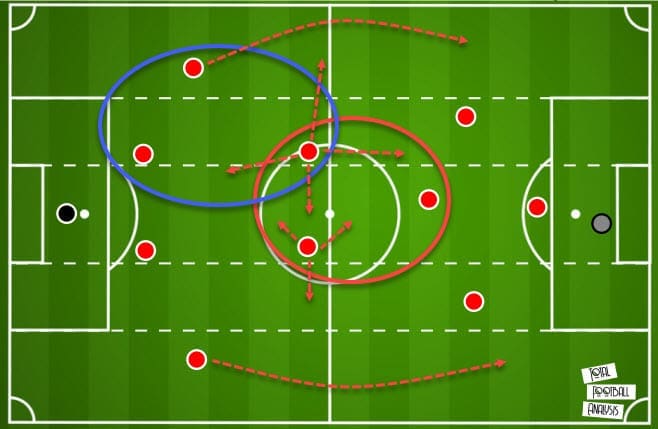
And while the relationship and connections on the pitch are mostly the same for both midfielders, just on the opposite side, the movement is different. One of them is more of a defensive midfielder while the other can be a deep playmaker.
De Jong fits the profile of the latter type. Notice that his role is freer and he gets the licence to both drop deeper and advance much higher up the pitch. We’ll get into the details a bit later into this scout report once the tactical analysis shifts to specific situations during a game.
When it comes to the final third, the double pivot will work in unison to form the team’s rest defence. Apart from that, they create key connections with the forwards on their respective sides.
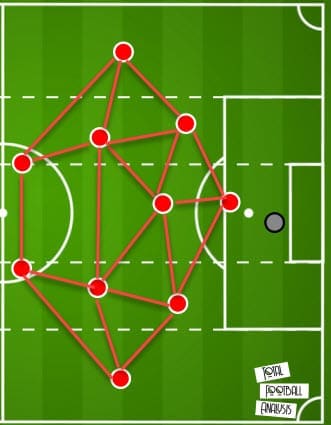
Above, we can see the passing network in the final third once the 4-2-3-1 transitions into the attacking phase. The centre midfielder’s main connections are then formed with his respective full-back, winger, centre-back, the attacking midfielder and finally, his pivot partner.
The main objectives of the more creative midfielder is often to progress the play and be the more attacking-minded of the two. Often, both will be tasked to overload certain areas of the pitch, specifically the half-spaces and the flanks by moving closer to the ball-carrier.
Aiding the build-up phase
It’s quite interesting to analyse De Jong’s role in Koeman’s build-up tactics. The key is to observe the difference between him and Busquets. As we’ve mentioned at the beginning of this tactical analysis, the two have different tasks on the pitch.
Below, we can see the comparison of their heatmaps in 2020/21. Apart from the fact that they’re operating on different sides, we can see that De Jong is dropping much deeper and also occasionally advancing higher as well.
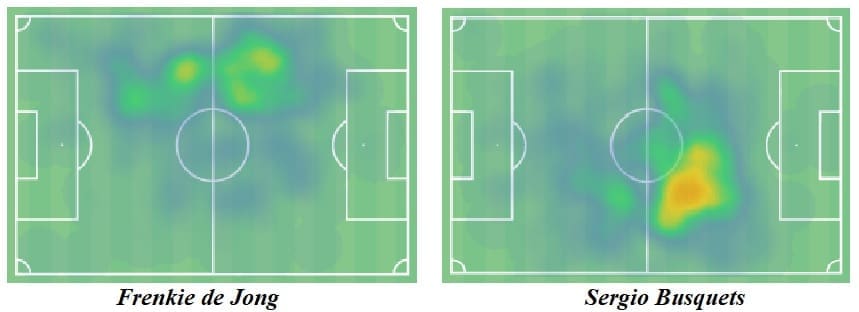
Of course, Busquets can also drop to help the ball progression but usually it will be De Jong who does that. We’ll also analyse Barcelona’s pass maps from the clashes with Sevilla and Celta Vigo.
In both of those, we can see that the Dutchman’s average position is slightly deeper than his teammate’s. Apart from that, their connections do seem to mirror each other’s quite well. But with De Jong dropping deeper, Busquets can stay higher and combine with Messi much easier, as can be seen from the pass maps as well.
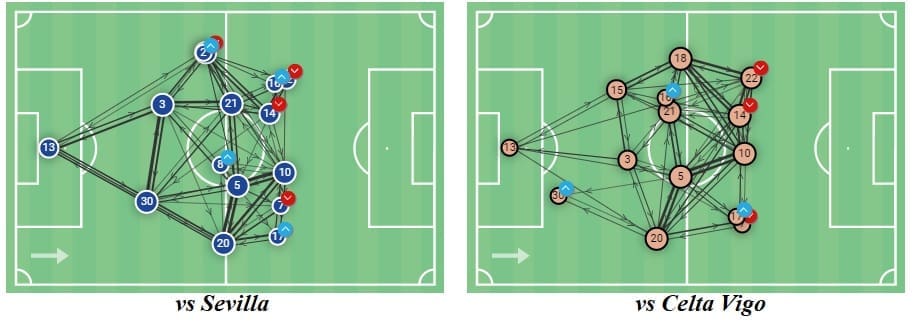
So how exactly does De Jong function in the build-up tactics? Koeman seems to prefer the young midfielder dropping down to the left centre-back position as opposed to the usual in-between position that is used with a single pivot.
When faced with a pressing squad of two, adding the third player into the backline ensures numerical superiority and easier ball progression. We can see such an example down below as De Jong drops to the left centre-back position, receives the ball and can then progress with it.
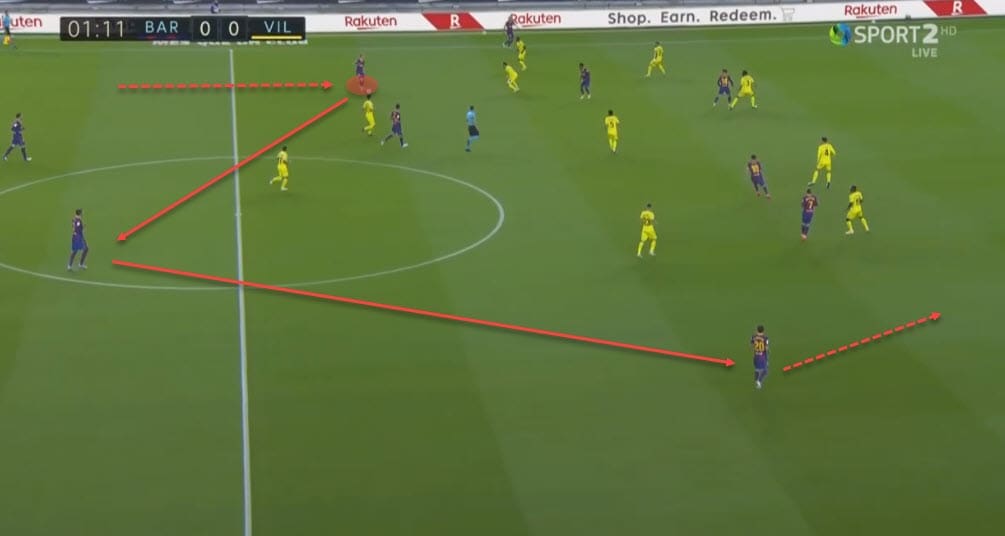
Even though he can’t continue on his run once he reaches the middle third, Barcelona have now conquered more territory and can then quickly swap sides to the free man on the opposite flank. De Jong recycles the ball back to Gerrard Piqué who quickly sends it over to Sergi Roberto to continue the attack.
This type of movement can also be done in the face of a high and aggressive press, such as the one the Catalans faced against Celta Vigo. Both of their centre-backs have a marker charging at them and De Jong quickly slots back into the backline to play a one-two with Clément Lenglet to avoid the press.
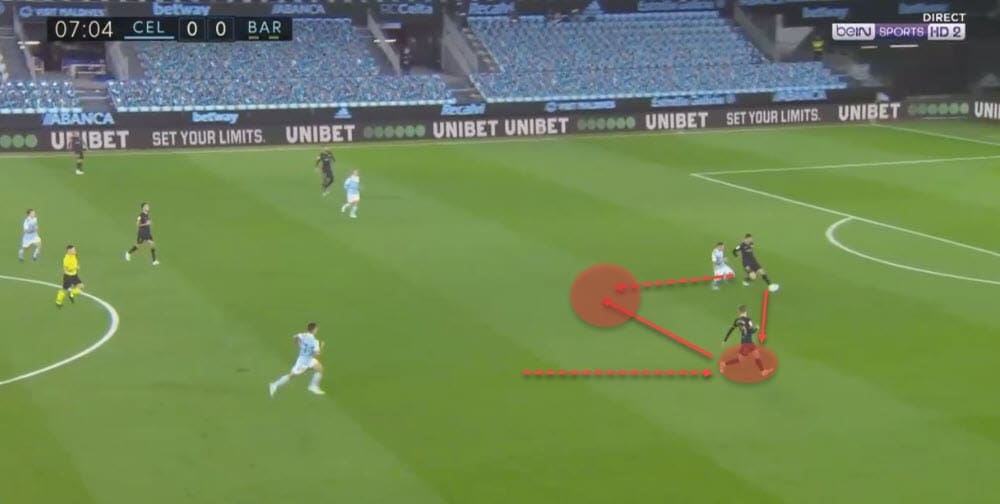
And while this is certainly an effective way to break the opposition’s attempts, sometimes it’s not that simple. One other type of movement we can see the pivots do in such situations is drifting wide to open a new passing channel.
For De Jong, this is usually done when Barcelona are pinned down in their half which also forces the full-backs, in this case Jordi Alba, to stay deep too. The Dutchman will then position himself just above the Spaniard in an almost straight line to receive the ball near the line.
Philippe Coutinho does the same and the three can combine to get Barcelona out of trouble.
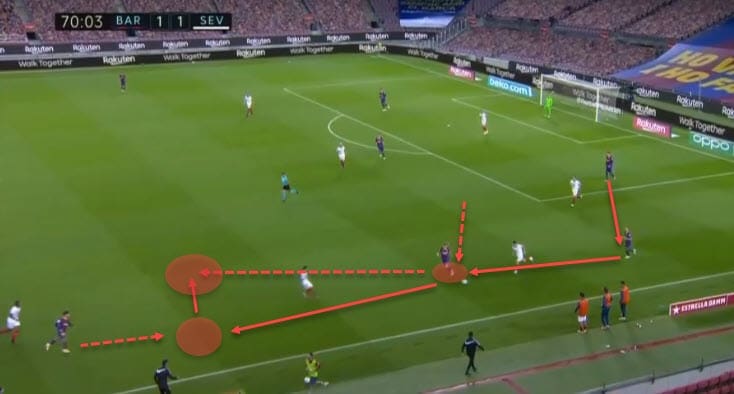
But the key here is to observe De Jong’s initial movement to drift wide and then his continued run up the pitch once he relays the ball to the Brazilian. This brings us to the highly effective skill that makes the Dutchman such a potent option for ball progression – his runs.
Running and dribbling to progress
De Jong’s exceptional ability to run with the ball is an incredible tool for Barcelona’s ball progression. It’s also one of the reasons why it’s him who drops deeper to receive from the backline more often than Busquets and it’s also him who gets more freedom going forward.
Before we start dissecting some of the in-game images, let’s observe a couple of graphs that will tell us more about the midfielder’s tendencies when in possession. We will take a look at his actions during counter-attacks and his ball progressions, both of which can be seen below.
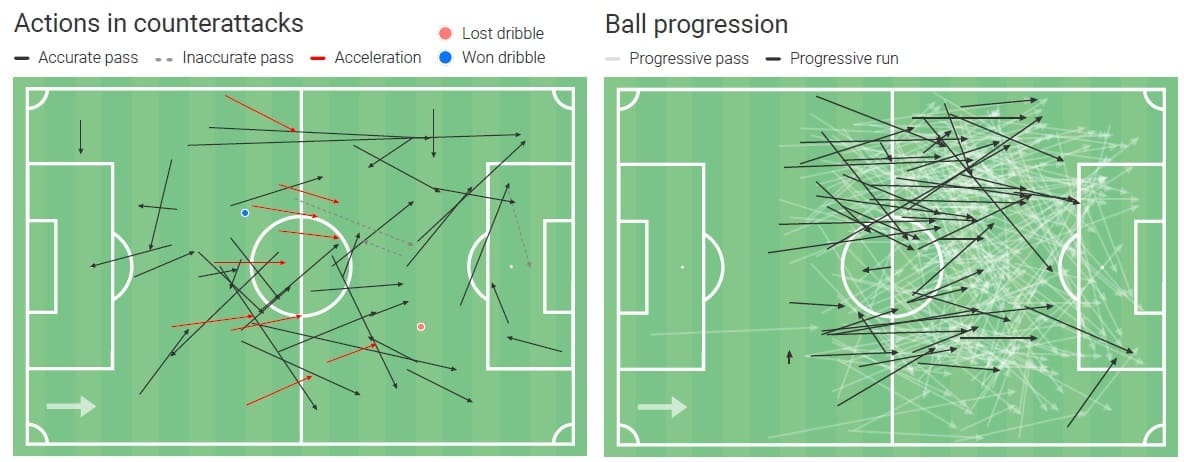
Of course, being the backbone of the Barcelona team along with Busquets, it doesn’t surprise that the duo are one of the most important distributors in the squad. However, notice in both images how often De Jong decides to run with the ball instead of just passing it forward.
Not only that but most of his runs start from the deep in his half and end in the opposition’s. The sheer distance he covers in a single action is also quite impressive and for that reason, Koeman prefers having him be the one to receive from the backline because he knows the Dutchman will be able to progress the play effectively.
Notice such an example in the image down below. De Jong receives the ball deep in his half and continues to run forward, beating his marker and then relaying the ball to Coutinho on the left.
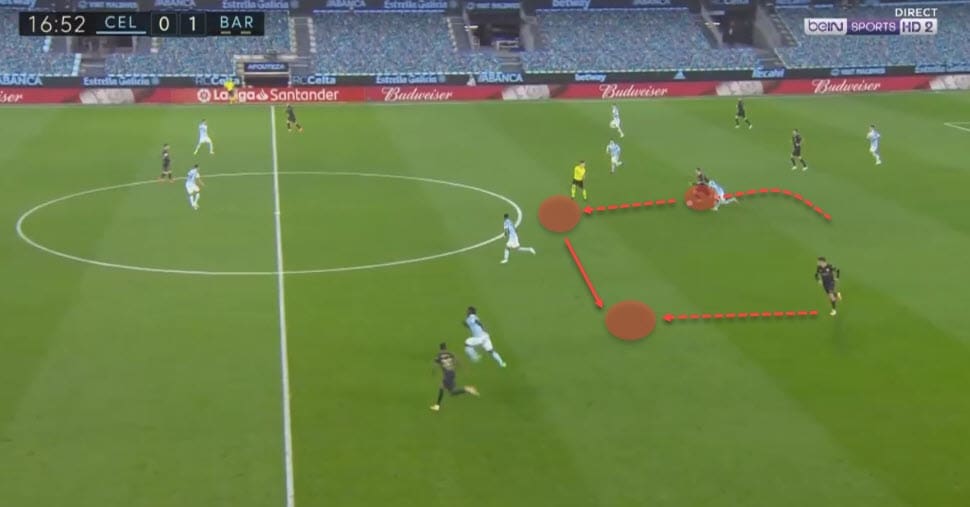
This is exactly what we’ve been talking about earlier in this scout report and exactly what the graphs have shown us. We’ll quickly take a look at another example in which, once again, De Jong drops deeper to help the build-up.
The scout report has already highlighted this to be one of his main roles in Koeman’s new system and being press-resistant and an excellent dribbler makes him the perfect candidate for that.
Below, the 23-year-old midfielder tries to elevate Sevilla’s press by opening a new passing channel to receive the ball from Roberto.
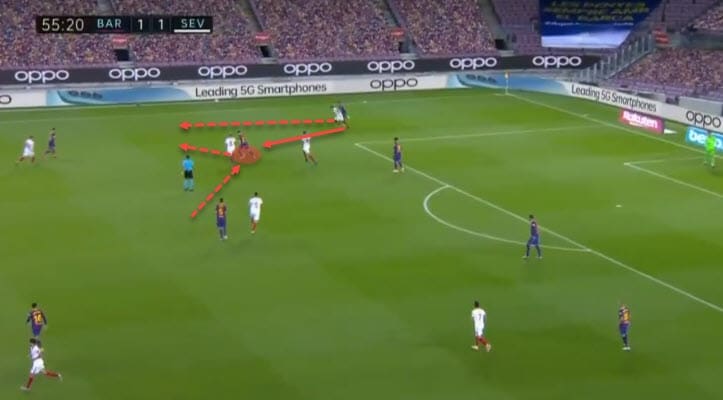
But what’s even more impressive is how he continues his run, beats the marker that is closing him down and then combines with Roberto once again. The full-back has also continued his run up the left flank and the two manage to progress the ball.
Once he’s in the right position and recognises the space up front, De Jong threads the ball ahead of his right-back and Barcelona can continue the attack.
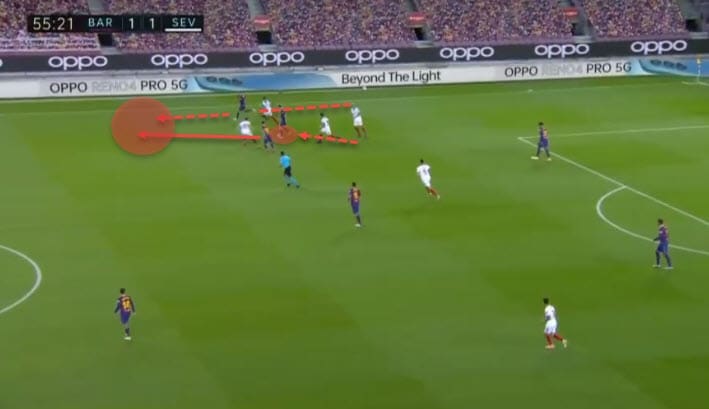
Finally, our tactical analysis will dissect Koeman’s tactics for his young star when entering the danger area in the final third of the pitch.
The danger area
This scout report has already shortly touched upon the final third tactics in the new Barcelona system. The 4-2-3-1 lands itself perfectly to creating triangles and connections between the player in all phases of play. Once they enter the final third, however, Koeman wants his squad to be fluid and dynamic, which often leads to swapping places and constant movement.
For that reason, it’s difficult to pin down a single recurring structure. However, using the initial graph as our guideline, we have managed to reconstruct it on the pitch and the example can be seen below.
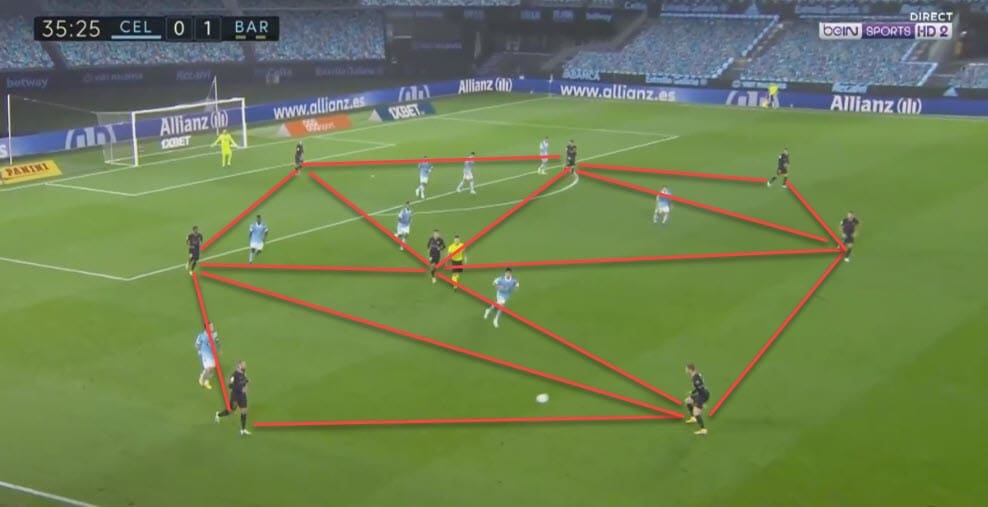
You can clearly see the network the system creates with multiple connections and passing channels available to each of the players. Looking specifically at the double pivot positions, we notice that both De Jong and Busquets have similar roles in maintaining the structure.
They will often act as Barcelona’s rest defence and will drift wide for cover since Koeman’s tactics include the highly attacking full-backs.
Below is another example of such a structure, this time against Sevilla and with a more fluid attacking line. The system is not as clean now, however, because of the dynamic nature of their approach and the chaotic phase of the attack.
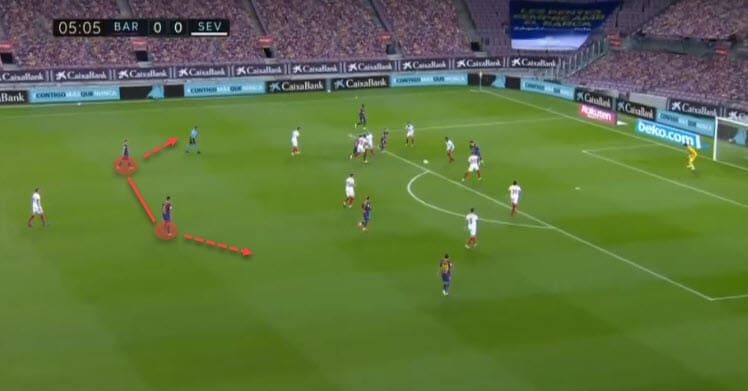
But De Jong and Busquets are still in their primary positions, acting as cover behind their attackers. This is usually their position from which they can distribute the ball into the box as well. Both of them can be used to quickly swap sides when necessary and recycle the ball to restart the attack.
Still, De Jong offers much more than just that in the final third. Below, we’ve analysed his penalty area deliveries and also his dribbles when entering the danger zone. The Dutchman’s passes area clearly targeting the half-spaces and are meant for runners in behind the defensive line.
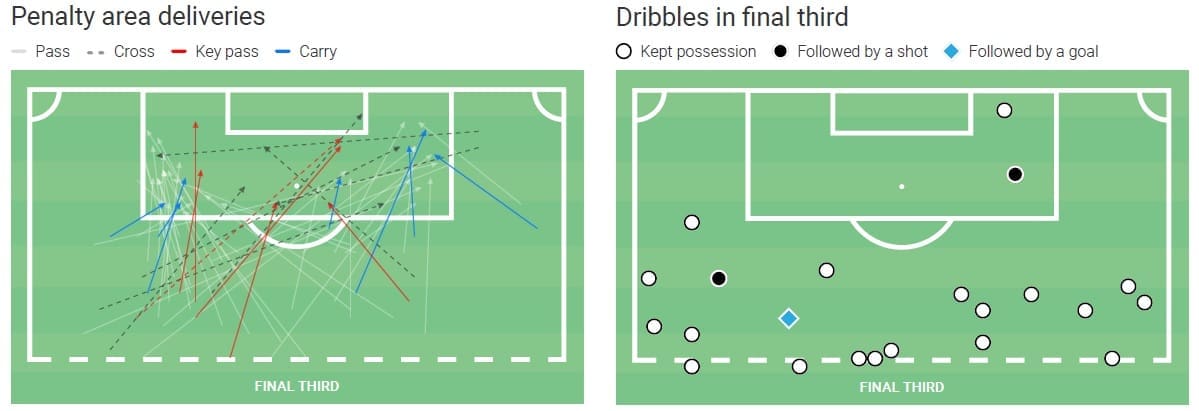
Four of those key passes have been deployed from this specific position in the left half-space, which is exactly where we’ll mostly see him once Barcelona enter the final third. But one other thing should be noticed here.
Apart from the passes, De Jong also loves to run into the box himself, indicated both by the blue arrows on the left and the dribbles graph on the right. This brings us to the final aspect we’ll dissect in this tactical analysis.
It does seem like Koeman’s attacking tactics often mean the Dutchman gets the freedom to run into the box himself. Through analysis of our admittedly small sample, it looks like De Jong is instructed to roam forward if and when Barcelona’s other creative forwards drop deeper.
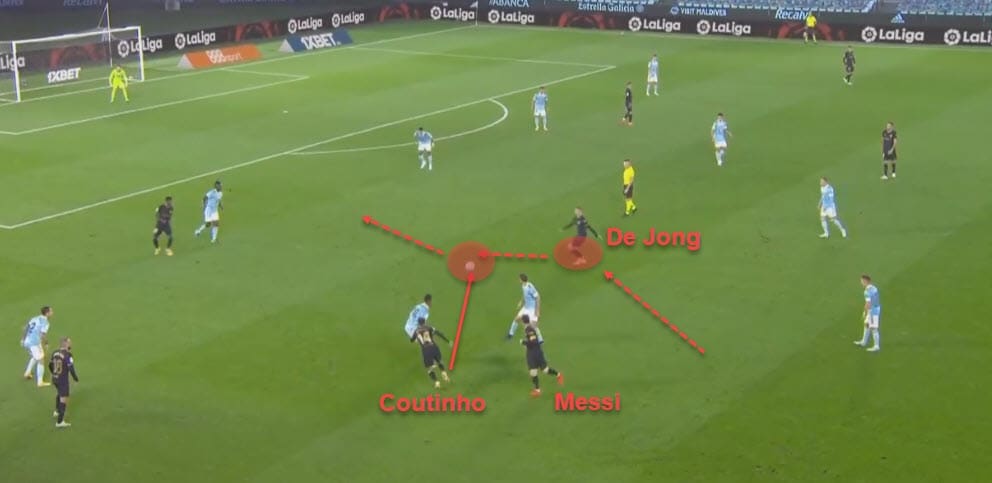
In this instance, both Coutinho and Messi are deeper on the pitch, leaving Fati alone higher up. This is immediately the trigger for De Jong to join him and move up. Of course, it’s not necessarily just Coutinho and Messi, this also applies to Fati and Alba as well.
This next example shows us a different situation with Coutinho and Fati being deeper on the pitch this time. The Brazilian plays the ball into the full-back, which is immediately the cue for De Jong to run into space up front.
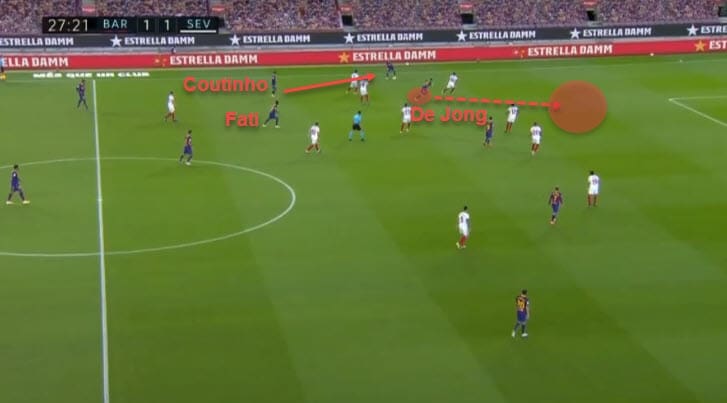
That’s also why we see so many runs into the box and generally into the final third on the graphs we’ve analysed earlier in the scout report.
Final remarks
This tactical analysis mostly focused on De Jong’s role in Koeman’s attacking tactics, except for the rest defence structure in the final third. That is mostly because there hasn’t been a big enough change in his defensive tasks so far with such a small sample of games.
If things do change further down the line of the season, we’ll make sure to cover it as well.






Comments